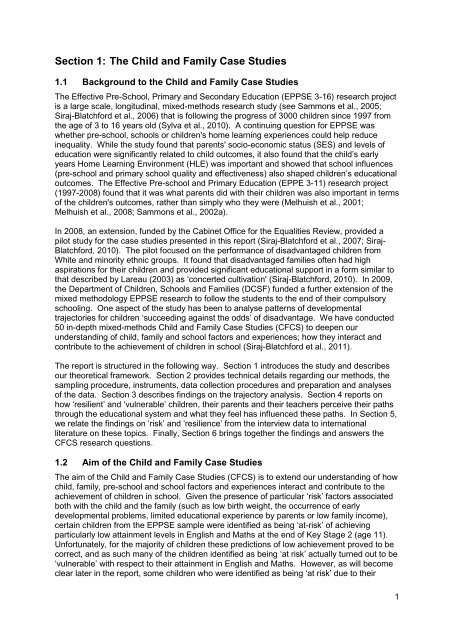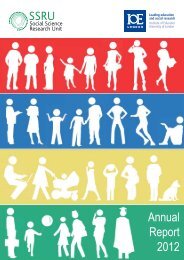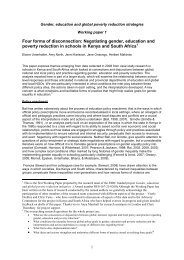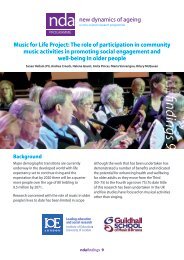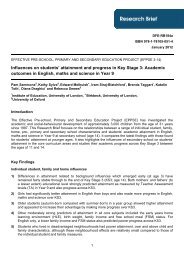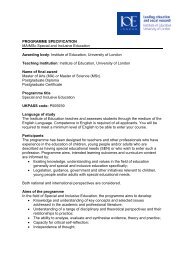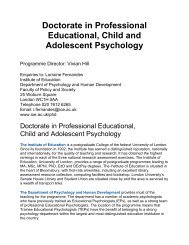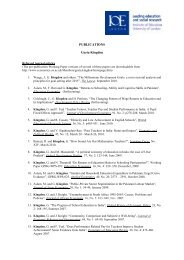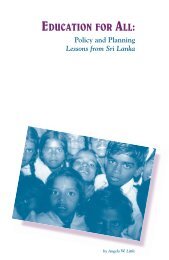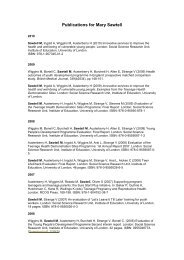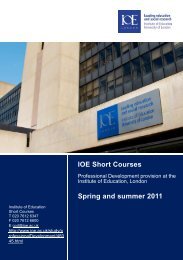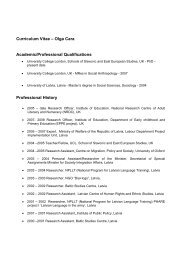Research report - Institute of Education, University of London
Research report - Institute of Education, University of London
Research report - Institute of Education, University of London
Create successful ePaper yourself
Turn your PDF publications into a flip-book with our unique Google optimized e-Paper software.
Section 1: The Child and Family Case Studies<br />
1.1 Background to the Child and Family Case Studies<br />
The Effective Pre-School, Primary and Secondary <strong>Education</strong> (EPPSE 3-16) research project<br />
is a large scale, longitudinal, mixed-methods research study (see Sammons et al., 2005;<br />
Siraj-Blatchford et al., 2006) that is following the progress <strong>of</strong> 3000 children since 1997 from<br />
the age <strong>of</strong> 3 to 16 years old (Sylva et al., 2010). A continuing question for EPPSE was<br />
whether pre-school, schools or children's home learning experiences could help reduce<br />
inequality. While the study found that parents' socio-economic status (SES) and levels <strong>of</strong><br />
education were significantly related to child outcomes, it also found that the child‟s early<br />
years Home Learning Environment (HLE) was important and showed that school influences<br />
(pre-school and primary school quality and effectiveness) also shaped children‟s educational<br />
outcomes. The Effective Pre-school and Primary <strong>Education</strong> (EPPE 3-11) research project<br />
(1997-2008) found that it was what parents did with their children was also important in terms<br />
<strong>of</strong> the children's outcomes, rather than simply who they were (Melhuish et al., 2001;<br />
Melhuish et al., 2008; Sammons et al., 2002a).<br />
In 2008, an extension, funded by the Cabinet Office for the Equalities Review, provided a<br />
pilot study for the case studies presented in this <strong>report</strong> (Siraj-Blatchford et al., 2007; Siraj-<br />
Blatchford, 2010). The pilot focused on the performance <strong>of</strong> disadvantaged children from<br />
White and minority ethnic groups. It found that disadvantaged families <strong>of</strong>ten had high<br />
aspirations for their children and provided significant educational support in a form similar to<br />
that described by Lareau (2003) as „concerted cultivation' (Siraj-Blatchford, 2010). In 2009,<br />
the Department <strong>of</strong> Children, Schools and Families (DCSF) funded a further extension <strong>of</strong> the<br />
mixed methodology EPPSE research to follow the students to the end <strong>of</strong> their compulsory<br />
schooling. One aspect <strong>of</strong> the study has been to analyse patterns <strong>of</strong> developmental<br />
trajectories for children „succeeding against the odds‟ <strong>of</strong> disadvantage. We have conducted<br />
50 in-depth mixed-methods Child and Family Case Studies (CFCS) to deepen our<br />
understanding <strong>of</strong> child, family and school factors and experiences; how they interact and<br />
contribute to the achievement <strong>of</strong> children in school (Siraj-Blatchford et al., 2011).<br />
The <strong>report</strong> is structured in the following way. Section 1 introduces the study and describes<br />
our theoretical framework. Section 2 provides technical details regarding our methods, the<br />
sampling procedure, instruments, data collection procedures and preparation and analyses<br />
<strong>of</strong> the data. Section 3 describes findings on the trajectory analysis. Section 4 <strong>report</strong>s on<br />
how „resilient‟ and „vulnerable‟ children, their parents and their teachers perceive their paths<br />
through the educational system and what they feel has influenced these paths. In Section 5,<br />
we relate the findings on „risk‟ and „resilience‟ from the interview data to international<br />
literature on these topics. Finally, Section 6 brings together the findings and answers the<br />
CFCS research questions.<br />
1.2 Aim <strong>of</strong> the Child and Family Case Studies<br />
The aim <strong>of</strong> the Child and Family Case Studies (CFCS) is to extend our understanding <strong>of</strong> how<br />
child, family, pre-school and school factors and experiences interact and contribute to the<br />
achievement <strong>of</strong> children in school. Given the presence <strong>of</strong> particular „risk‟ factors associated<br />
both with the child and the family (such as low birth weight, the occurrence <strong>of</strong> early<br />
developmental problems, limited educational experience by parents or low family income),<br />
certain children from the EPPSE sample were identified as being „at-risk‟ <strong>of</strong> achieving<br />
particularly low attainment levels in English and Maths at the end <strong>of</strong> Key Stage 2 (age 11).<br />
Unfortunately, for the majority <strong>of</strong> children these predictions <strong>of</strong> low achievement proved to be<br />
correct, and as such many <strong>of</strong> the children identified as being „at risk‟ actually turned out to be<br />
„vulnerable‟ with respect to their attainment in English and Maths. However, as will become<br />
clear later in the <strong>report</strong>, some children who were identified as being „at risk‟ due to their<br />
1


